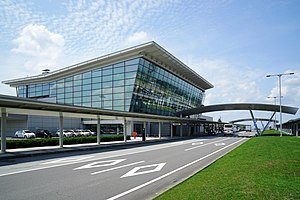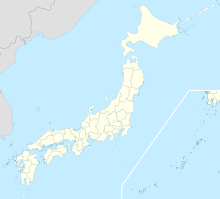Asahikawa Airport
|
Asahikawa Airport 旭川空港 Asahikawa Kūkō |
|||||||||||
|---|---|---|---|---|---|---|---|---|---|---|---|
 |
|||||||||||
| Summary | |||||||||||
| Airport type | Public | ||||||||||
| Owner | Japanese government | ||||||||||
| Operator | City of Asahikawa | ||||||||||
| Serves | Asahikawa, Hokkaidō, Japan | ||||||||||
| Location | Higashikagura, Hokkaido | ||||||||||
| Elevation AMSL | 690 ft / 210 m | ||||||||||
| Coordinates | 43°40′15″N 142°26′51″E / 43.67083°N 142.44750°ECoordinates: 43°40′15″N 142°26′51″E / 43.67083°N 142.44750°E | ||||||||||
| Map | |||||||||||
| Location in Japan | |||||||||||
| Runways | |||||||||||
|
|||||||||||
| Statistics (2015) | |||||||||||
|
|||||||||||
|
Source: Japanese Ministry of Land, Infrastructure, Transport and Tourism
|
|||||||||||
| Passengers | 1,148,825 |
|---|---|
| Cargo (metric tonnes) | 5,346 |
| Aircraft movement | 8,045 |
Asahikawa Airport (旭川空港 Asahikawa Kūkō?) (IATA: AKJ, ICAO: RJEC), is a single-runway regional airport in Hokkaidō, Japan, straddling the cities of Asahikawa and Higashikagura.
Planning of the airport began in the late 1950s. The airport site was chosen in November 1960 and received government approval in 1963. Japan Domestic Airlines began the first scheduled flight to Asahikawa on July 1, 1966, a NAMC YS-11 service to Haneda Airport via Okadama Airport. Scheduled service was on a seasonal basis (May through October) until 1970, when year-round flights to Tokyo began.
The airport was closed for expansion work from May 1981 until February 1982, during which time the main runway was extended and widened, from 1,200 x 30 m to 1,640 m x 45 m. A further extension to 2,000 m was completed in November 1982. Following these expansions, jet service began at the airport, beginning with DC-9 and MD-80 aircraft followed by widebody Airbus A300s beginning in December 1983. ANA operated the first international charter flight from Asahikawa in 1987. Another runway extension, to 2,500 m, was completed in 1997, and the parallel taxiway opened in 1998.
Scheduled international service to Seoul began in 2006, using new international facilities in the airport terminal. In 2016, plans were finalized to build a new 5,700 m² international terminal to the south of the existing terminal, with a target of 500,000 international passengers per year by 2030.
...
Wikipedia

